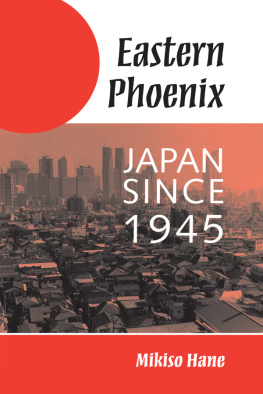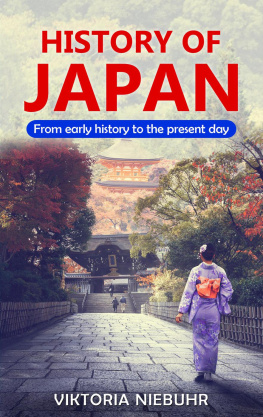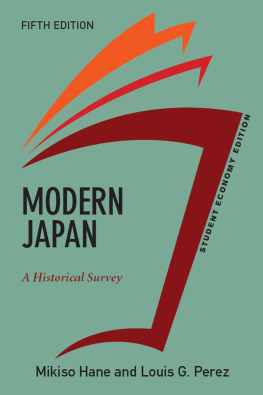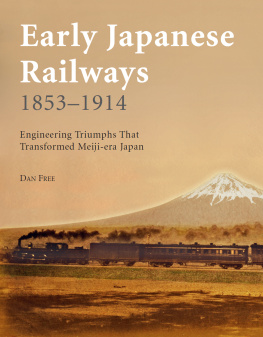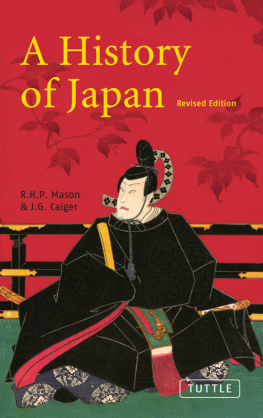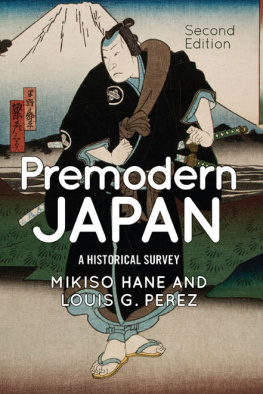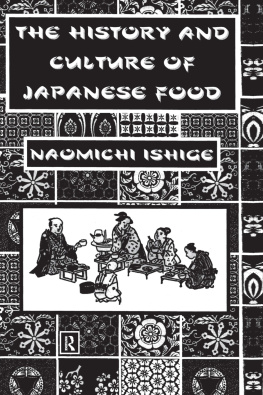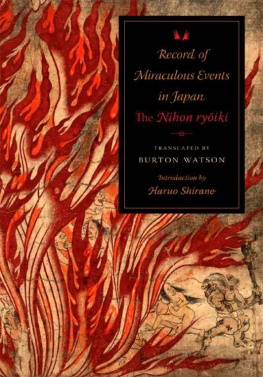PREMODERN
JAPAN

Westview Press was founded in 1975 in Boulder, Colorado, by notable publisher and intellectual Fred Praeger. Westview Press continues to publish scholarly titles and high-quality undergraduate- and graduate-level textbooks in core social science disciplines. With books developed, written, and edited with the needs of serious nonfiction readers, professors, and students in mind, Westview Press honors its long history of publishing books that matter.
Copyright 2015 by Westview Press
Published by Westview Press,
A Member of the Perseus Books Group
All rights reserved. No part of this book may be reproduced in any manner whatsoever without written permission except in the case of brief quotations embodied in critical articles and reviews. For information, address Westview Press, 2465 Central Avenue, Boulder, CO 80301.
Find us on the World Wide Web at www.westviewpress.com.
Every effort has been made to secure required permissions for all text, images, maps, and other art reprinted in this volume.
Westview Press books are available at special discounts for bulk purchases in the United States by corporations, institutions, and other organizations. For more information, please contact the Special Markets Department at the Perseus Books Group, 2300 Chestnut Street, Suite 200, Philadelphia, PA 19103, or call (800) 810-4145, ext. 5000, or e-mail .
Library of Congress Cataloging-in-Publication Data
Hane, Mikiso.
Premodern Japan : a historical survey / Mikiso Hane, late of Knox College, Louis G. Perez, llinois State University. Second edition.
pages cm
Includes bibliographical references and index.
ISBN 978-0-8133-4970-1 (e-book : alk. paper) 1. JapanHistoryTo 1868. I. Perez, Louis G. II. Title.
DS850.H36 2014
952dc23
2014032427
10 9 8 7 6 5 4 3 2 1
Contents
In many ways this revision is decades overdue. My late good friend Mikiso Hane first wrote the early half of a two-volume history (Japan: A Historical Survey) in 1972. Then he revised it somewhat to stand alone as Premodern Japan: A Historical Survey. In 1991 he revised it again. That version has not been revised since. Miki once told me that he intended to bring it up to date at the turn of the twenty-first century. He never got around to it; he passed away in 2003.
I rewrote Mikis modern Japan half of the textbooktwice, in fact. After a decade, I took up the premodern half. You have the results in your hands. Generally speaking, I have tried to retain Mikis voice wherever I could. His work on religion, the arts, and culture are still magnificent. Students tell me that his prose is still clear and easy to understand after four decades. Unless there has been a significant change in consensus, I have retained his words and interpretations.
A Word About Sources and Citations
I have chosen to put source citations and clarifications at the end of each chapter for quick and easy reference and to avoid cluttering up the flow of the narrative. I have retained almost all of Mikis citations except for those clearly out of date. His translations from Japanese are retained. Miki was a great translator; we owe much to him for access to some great Japanese scholars, Maruyama Masao especially. Translation is a tough job; most of us have tried it, if only because our dissertations required it. In my own case, I always feel like the shade-tree mechanic in that I find leftover parts and pieces after I am done.
I have used the endnotes to cite sources for new quotations I have employed but also to suggest particularly good sources that a student might consult to flesh out what I have suggested. Long ago (in the previous century) when I was an undergrad, I valued most those histories that provided suggested readings right in the footnotes.
Regarding the new bibliography, I have found that recent scholarship has nearly doubled since Mikis last edition. This is mostly due to the explosion of higher education in the last half century. In former times only wealthy people could afford to send their children to college, and then few would waste the effort by allowing them to pursue esoteric topics like Japanese history. The idea of the first child of a Chicano illegal immigrant farm worker family to graduate from high school spending much time in college puzzling out Japanese history was unimaginable. By far the best of the new stuff is in what has been called the subaltern voice. The influx of women into the profession has profoundly changed it. We must remember that Miki was among the very first to include discussions on gender, sexuality, and the nonpeople (variously called hinin and eta). As Jim Huffman eloquently noted in Mikis obituary, he had led the way for his American peers in making women, workers, and peasants a serious part of the narrative.
Because this revision is intended to make Japanese history more readily available to younger scholars, I have chosen to cite only English-language sources. Citations to Japanese-language sources are retained in the endnotes for each chapter to cite sources for Mikis translations.
To facilitate the use of the bibliography, I have added new subsections (The Arts, Gender and Sexuality, Religion, etc.) for quick reference. When in doubt about a new source, I have repeated the entry in more than one section. I have tried to keep that to a minimum in the interest of space.
Illustrations
The folks at Westview Press have commissioned cartographers to delineate changes that I think can best be expressed in line maps. I chose not to bring in new full-color illustrations because they drive up the price for the book beyond what I believe to be reasonable. If one wants to see a plethora of excellent color illustrations, one only has to type in names and places (Hiroshige, Utamaro, Kabuki, Ise, etc.) into a decent search engine, and one has access to scores of examples. Please see the appendix on the use of the Internet at the end of the book.
Names and Transliteration
The Hepburn system of transliteration of the Japanese language will be employed. This entails using the shi instead of si, using n at the end of some words to indicate that sound (the only consonant without a vowel sound), as well as the use of macrons (small horizontal marks, as in Chsh) to indicate elongated vowels. Surnames are written first (e.g., Tokugawa Ieyasu) followed by the given or personal name, but we will use the personal name when differentiating between two people with the same surname (e.g., Ieyasu and Nariaki, both named Tokugawa). The only exceptions will be when the person is better known using the Western system (Mikiso Hane or D. T. Suzuki). Also, place names that should be written with macrons that are now more commonly written without (Tky vs. Tokyo or saka vs. Osaka) will appear in their modernized form. We will employ the new Pinyin style (Beijing) instead of the old Wade-Giles (Peking) for Chinese unless the latter system is used in a quotation or title (Peking duck).
Thanks!
I wish to thank all the folks who contributed to this revision. My good friend Betsy Dorn Lublin kindly read the first draft, as did seven anonymous reviewers employed by Westview Press. I also wish to thank (alphabetically) Sydney DeVere Brown, Roy Hanashiro, Ethan Segal, James Stanlaw, and Roger Thomas for ideas, clarifications, and kind words of encouragement along the way. Obviously, all the editors at Westview over the decade are appreciated for their patience. I know the publication of textbooks is a vested-interest business, but these folks have served beyond the call of duty.
My students at Illinois State University have also provided me with help and suggested revisions during the last eighteen months. I taught Premodern Japanese History twice during that time, using this textbook. I often asked them what they liked and didnt like and what wasnt clear. I have employed their suggestions. This is the only credit they will get.
Next page

